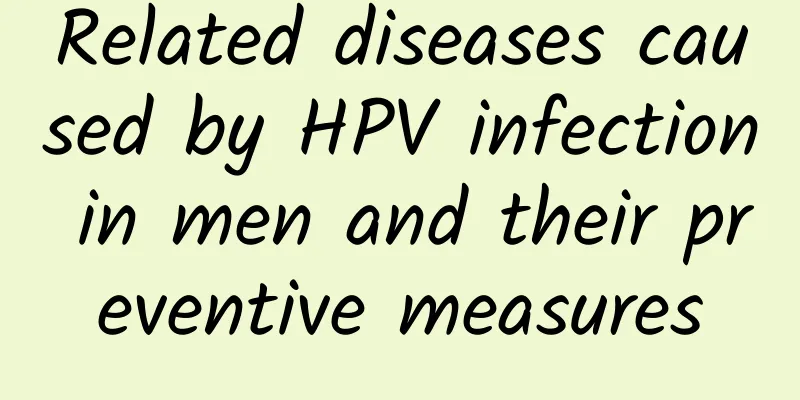Related diseases caused by HPV infection in men and their preventive measures

|
Human papillomavirus (HPV) is a very common pathogen among sexually transmitted diseases. Globally, the lifetime risk of infection with the virus in men can reach 90%, while it is about 80% in women. Although the role of HPV in cervical cancer in women has been widely studied, HPV-related diseases in men have long been underestimated. In recent years, the association between HPV infection and male head and neck cancer, anal cancer, penile cancer, genital warts and male infertility has gradually been revealed, highlighting the importance of HPV prevention and control in men. HPV belongs to the papillomavirus family. It is a double-stranded circular DNA virus that specifically invades mucosal and epithelial cells. Based on the genome sequence of the gene L1 encoding the major capsid protein, scientists have identified more than 200 HPV subtypes, which are roughly divided into high-risk and low-risk types. Low-risk HPV subtypes are believed to be the cause of skin and plantar warts, and oral, anal, genital warts or genital warts are closely related to infection with low-risk HPV subtypes. The most common high-risk HPV subtypes include HPV-16, 18, 31, 33, 35, 39, 45, 51, 52, 56, 58, 59, 66, and 68. Types 16 and 18 can cause related cancers (including cervical cancer, anal cancer, penile cancer, and oropharyngeal cancer). The International Agency for Research on Cancer has provided strong evidence for the role of HPV in the development of cervical cancer, penile cancer, vulvar cancer, vaginal cancer, anal cancer, and oropharyngeal cancer. In addition, HPV is more likely to attack people with weakened immune systems, making them more susceptible to related diseases. 1. Diseases associated with HPV infection in men Most HPV infections are asymptomatic, transient infections that will be cleared by the body, but a few will persist and eventually lead to related diseases, as shown in Figure 1. Figure 1 Diseases associated with HPV infection in men (Reference 4) 1. Head and neck diseases (1) Head and neck squamous cell carcinoma (HNSCC): In recent years, the incidence of HNSCC associated with HPV infection has increased significantly. HPV plays an important role in the etiology of head and neck squamous cell carcinoma. Infection with high-risk HPV drives tumor development by expressing oncoproteins E6 and E7. Among HNSCC caused by HPV infection, HPV-16 and HPV-18 subtypes account for 85%, and the remaining 15% of HPV subtypes are mainly HPV-33, HPV-35, HPV-52, HPV-45, HPV-39 and HPV-58. It is worth mentioning that HPV has recently been found to be associated with middle ear squamous cell carcinoma (MESCC), a rare subtype of head and neck cancer. (2) Oropharyngeal squamous cell carcinoma (OSCC): Oropharyngeal squamous cell carcinoma is also a type of head and neck cancer. About 50% of OPSCC cases are associated with high-risk HPV (such as HPV-16 and HPV-18). The tonsil crypts, their irregular surfaces, and the tongue-based lymphoid tissue create a favorable environment for persistent HPV infection, increasing the risk of developing oropharyngeal squamous cell carcinoma. In addition, studies have shown that tongue cancer, tonsil cancer, and laryngeal cancer are also associated with HPV infection. 2. Urinary system diseases (1) Anal cancer: Public data show that approximately 90% of anal cancers are attributed to persistent HPV infection, with high-risk HPV-16 being the dominant type. (2) Penile cancer: Penile cancer is an invasive and relatively rare squamous cell carcinoma that occurs in the glans penis or the inner layer of the foreskin. It is characterized by invasive growth and early metastasis to the lymph nodes. HPV infection is detected in 30% to 50% of penile cancer cases, of which HPV-16 accounts for 30.8%. (3) Prostate cancer: Some studies suggest that HPV infection may promote the occurrence of prostate cancer, but the evidence remains controversial. (4) Testicular cancer: The role of HPV in testicular cancer is controversial. However, the prevalence of HPV in semen is high in patients with testicular cancer. Therefore, foreign experts recommend HPV screening when diagnosing testicular cancer patients, because HPV infection can in turn induce cancer in many parts of the body. (5) Genital warts and condyloma acuminatum: mainly caused by low-risk HPV-6 and HPV-11, and are one of the most common clinical manifestations of HPV infection. 3. Male reproductive system diseases HPV can affect fertility by infecting sperm, leading to decreased sperm motility (asthenozoospermia), increased DNA fragmentation index, and the formation of anti-sperm antibodies. HPV is detected in the semen of about 16% of men with unexplained infertility, which is significantly higher than the general population. Animal experiments have shown that HPV infection may interfere with embryonic development (such as HPV-16 and 31 subtypes) and implantation rate (such as HPV-11, 16, 18 and 31 subtypes), reducing the success rate of assisted reproductive technology. In addition, the negative effects of HPV in male infertility may also be related to increased infection of other bacteria in accessory glands (seminal vesicles, prostate, and bulbourethral glands). The guidelines for medical assisted reproduction issued by the European Society of Human Reproduction and Embryology point out that HPV in semen is the only viral factor that is clinically associated with assisted reproductive results. For infertile couples with HPV semen infection who receive assisted reproduction, it is recommended to adopt a new strategy of sperm washing and HPV adjuvant vaccination. II. Prevention and Control Measures Currently, HPV vaccines for men are on the market, and vaccination with HPV vaccines can play an effective preventive role. For example, the nine-valent vaccine (Gardasil-9) can prevent infections with HPV-6, 11, 16, 18, 31, 33, 45, 52, and 58, covering 90% of carcinogenic types. In addition, HPV vaccination has a therapeutic auxiliary effect. For men who have been infected with HPV, vaccination can accelerate the clearance of the virus. Studies have shown that 86% of vaccine recipients achieve semen HPV-DNA conversion to negative within 6 months and improve sperm parameters. A Lancet sub-journal study found that for men aged 16 to 26, the quadrivalent HPV vaccine showed excellent preventive efficacy, especially in significantly reducing the incidence of external genital lesions and anal diseases caused by HPV6, 11, 16, and 18 viruses. The results are particularly significant. 3. Screening and diagnosis Screening is recommended for high-risk groups, including those with HPV-positive partners, those with genital warts or precancerous lesions, men who have sex with men, those infected with HIV, and men with unexplained infertility. IV. Treatment Strategies Surgery: Surgical resection of HPV-related precancerous lesions (such as penile intraepithelial neoplasia) or malignant tumors (such as OPSCC). V. Public Education and Policy Promotion Raise awareness of HPV infection among men, especially the importance of popularizing vaccination for adolescents and young men. Medical professionals need to strengthen screening and education for HPV-related diseases in high-risk groups. VI. Conclusion and Outlook The disease burden of HPV infection in men is becoming increasingly significant, involving cancer, reproductive health and other aspects. Vaccination is the core means of preventing HPV-related diseases, but the global vaccination rate is still not ideal, especially among men, which needs to be strengthened urgently. In the future, it is necessary to further optimize screening strategies, develop new therapeutic vaccines, and improve the coverage and accuracy of the HPV prevention and control system through multidisciplinary cooperation. References [1]Ntanasis-Stathopoulos I, Kyriazoglou A, Liontos M, A Dimopoulos M, Gavriatopoulou M. Current trends in the management and prevention of human papillomavirus (HPV) infection. J BUON. 2020;25(3):1281-1285. [2]Araldi RP, Sant'Ana TA, Módolo DG, et al. The human papillomavirus (HPV)-related cancer biology: An overview. Biomed Pharmacother. 2018;106:1537-1556. [3]Bruni L, Albero G, Rowley J, et al. Global and regional estimates of genital human papillomavirus prevalence among men: a systematic review and meta-analysis. Lancet Glob Health. 2023;11(9):e1345-e1362. [4]VGarolla A, Graziani A, Grande G, Ortolani C, Ferlin A. HPV-related diseases in male patients: an underestimated conundrum. J Endocrinol Invest. 2024;47(2):261-274. [5]Goldstone SE, Giuliano AR, Palefsky JM, et al. Efficacy, immunogenicity, and safety of a quadrivalent HPV vaccine in men: results of an open-label, long-term extension of a randomized, placebo-controlled, phase 3 trial. Lancet Infect Dis. 2022;22(3):413-425. Author: Cao Longbin, Chief Technician, Medical Laboratory Department, Seventh Affiliated Hospital of Southern Medical University |
<<: The Devil in the Head: Gliomas
Recommend
Be careful, these "mountain and sea delicacies" are attacking your summer vacation
Author: Li Haijie, School of Public Health, North...
Are there any pregnant women who have been bleeding during pregnancy?
Perhaps everyone knows that women will experience...
Breastfeeding diet to lose 10 pounds in a week
I believe it is every woman’s dream to have a cha...
What causes pain on the right side of the uterus?
Women always suffer from various gynecological di...
What causes brown vaginal discharge without odor?
Generally speaking, the vagina is acidic, which c...
What are the contents of the fetal examination during the third month of pregnancy?
After pregnancy, female friends must pay attentio...
Can pregnancy spots be removed?
For many pregnant mothers, they hope to restore t...
39 weeks pregnant with bloody vaginal discharge
The early and late stages of pregnancy are the mo...
How to exercise to enlarge breasts?
It is often said that when you get fat, your face...
Can menstruation cause dizziness?
Women will lose a certain amount of blood during ...
What does follicular echo mean?
Follicular echo is a normal situation, but if the...
Excessive sweating and weakness after medical abortion
Most women are very weak, so they must pay attent...
What is the reason for the growth of white hair in the pubic area?
Why does male pubic hair turn the skin white? We ...
Brown discharge two days before menstruation
Many female friends always feel abnormal reaction...









